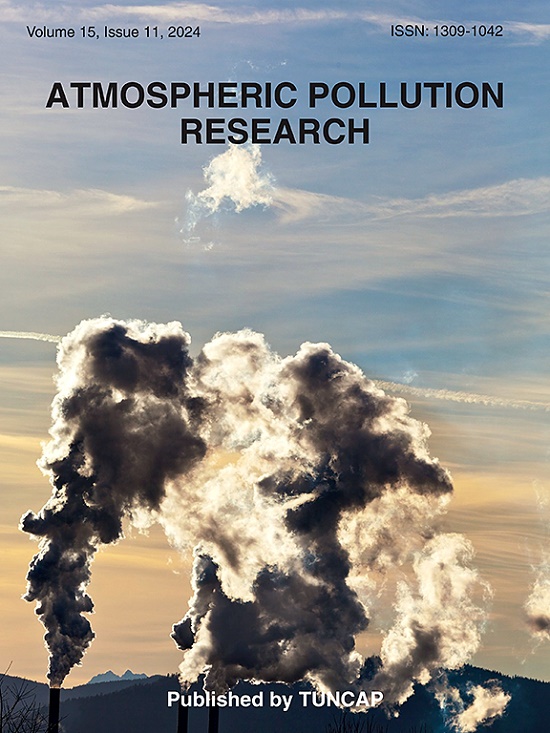Biomonitoring of elements airborne pollution in European Mediterranean region by two Tillandsia species
IF 3.5
3区 环境科学与生态学
Q2 ENVIRONMENTAL SCIENCES
引用次数: 0
Abstract
Tillandsia genus belongs to the Bromeliaceae family plants and some species display active or passive biomonitoring capacities in their natural habitat as it has been described mostly in the American continent. However, Tillandsia aeranthos (Loisiel.) Desf. and Tillandsia bergeri Mez have never been studied for their metal air pollution biomonitor potential. A recent study conducted in our laboratory brought to light the maximum capacity of elements bioconcentration into these two species leaves. The aim of the present study is to determine if T. aeranthos and T. bergeri acclimated to Southern/European region are good biomonitors for airborne elements pollution. Twelve elements were chosen to evaluate the biomonitoring potential (As, Ba, Co, Cr, Cu, Fe, Mn, Ni, Pb, Sn, Ti and Zn). After sampling, the content of the twelve elements in leaves was measured by Inductively Coupled Plasma-Optical Emission Spectrometry and Inductively Coupled Plasma-Mass Spectrometry. Data sets were treated according to sampling sites by box plots over time and Principal Component Analysis. The results showed differences between the two species, with T. bergeri possessing a higher capacity in accumulating elements than T. aeranthos. Fe, Zn and Co showed a higher contribution in the accumulation process in the two Tillandsia species leading to the hypothesis of a good affinity of the two species with these elements. Values obtained for five elements (As, Cr, Ni, Pb and Zn) were compared with values recorded by a monitoring station close to sampling sites showing the efficiency of these two Tillandsia species as biomonitors. High Co accumulation rates obtained in both Tillandsia species were particularly intriguing but could not be rationalized as this metal is not currently monitored by air pollution station in this region. T. aeranthos and T. bergeri proved their efficiency for the biomonitoring of elements air pollution, especially for Co, Fe and Zn.

欧洲地中海地区两种莲属植物空气污染元素的生物监测
凤梨属植物属于凤梨科植物,部分种类在其自然生境中表现出主动或被动的生物监测能力,主要分布在美洲大陆。然而,Tillandsia aeranthos (Loisiel.)Desf。和Tillandsia bergeri Mez的金属空气污染生物监测潜力从未被研究过。最近在我们实验室进行的一项研究揭示了这两种植物叶片中元素生物浓缩的最大容量。本研究的目的是确定适应于南欧/欧洲地区的气浮梭菌和伯格氏梭菌是否是空气中元素污染的良好生物监测仪。选取As、Ba、Co、Cr、Cu、Fe、Mn、Ni、Pb、Sn、Ti、Zn等12种元素评价其生物监测潜力。取样后,采用电感耦合等离子体发射光谱法和电感耦合等离子体质谱法测定叶片中12种元素的含量。数据集根据采样地点按时间的箱形图和主成分分析进行处理。结果表明,两种植物之间存在差异,伯格氏菌的元素积累能力高于浮藻。铁、锌和钴在两种莲属植物的积累过程中表现出较高的贡献,从而假设两种莲属植物与这些元素具有良好的亲和力。将获得的5种元素(As, Cr, Ni, Pb和Zn)的值与靠近采样点的监测站记录的值进行了比较,显示了这两种Tillandsia物种作为生物监测点的效率。在这两个品种中获得的高Co积累率特别有趣,但由于该地区目前没有空气污染站监测这种金属,因此无法合理解释。空气梭菌和伯格氏菌对大气中元素污染的监测效果较好,特别是对Co、Fe和Zn的监测效果较好。
本文章由计算机程序翻译,如有差异,请以英文原文为准。
求助全文
约1分钟内获得全文
求助全文
来源期刊

Atmospheric Pollution Research
ENVIRONMENTAL SCIENCES-
CiteScore
8.30
自引率
6.70%
发文量
256
审稿时长
36 days
期刊介绍:
Atmospheric Pollution Research (APR) is an international journal designed for the publication of articles on air pollution. Papers should present novel experimental results, theory and modeling of air pollution on local, regional, or global scales. Areas covered are research on inorganic, organic, and persistent organic air pollutants, air quality monitoring, air quality management, atmospheric dispersion and transport, air-surface (soil, water, and vegetation) exchange of pollutants, dry and wet deposition, indoor air quality, exposure assessment, health effects, satellite measurements, natural emissions, atmospheric chemistry, greenhouse gases, and effects on climate change.
 求助内容:
求助内容: 应助结果提醒方式:
应助结果提醒方式:


